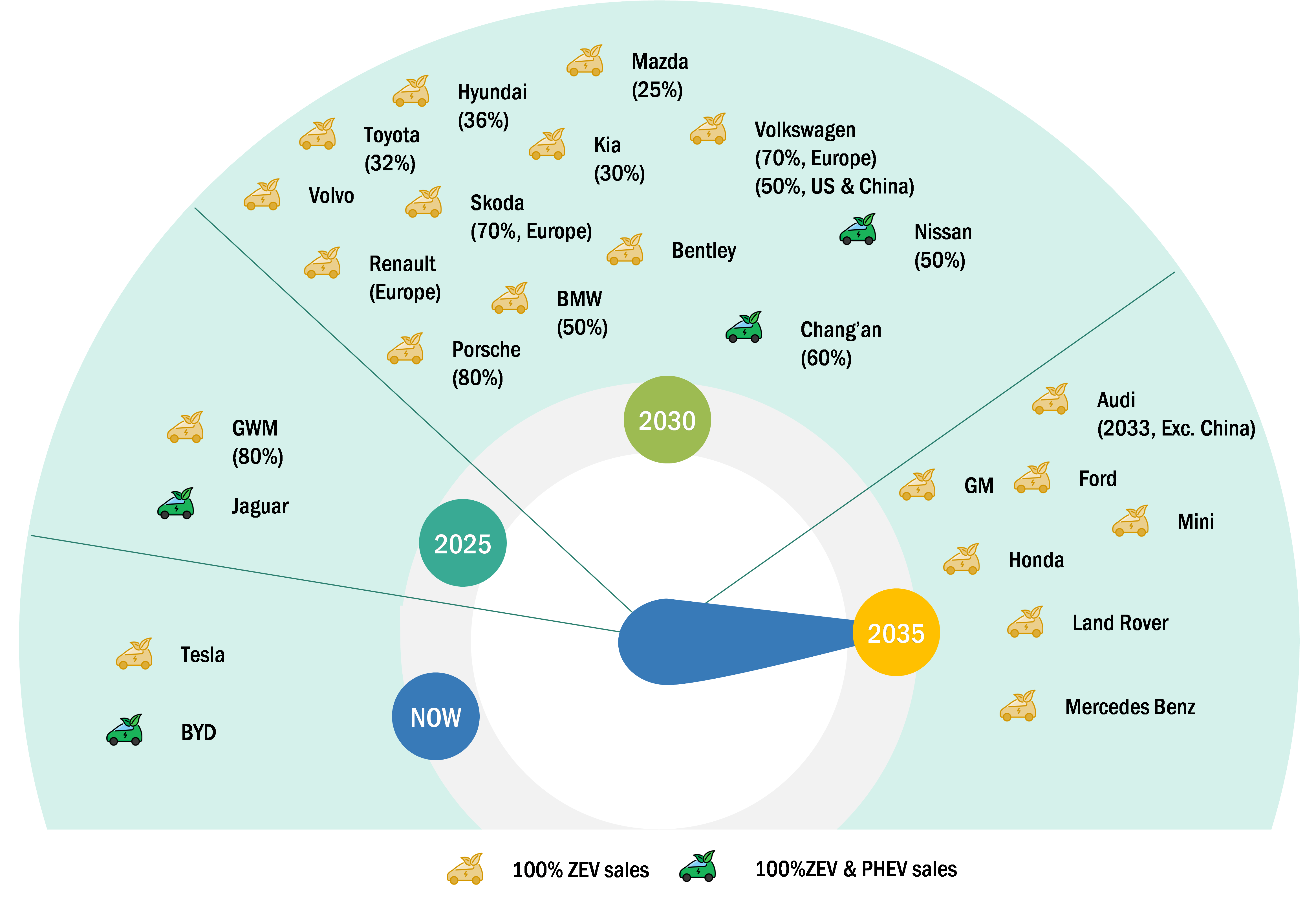
CHARGED UP: SHIFT TO E-MOBILITY AND THE EVOLUTION OF TRANSPORTATION
In the rapidly evolving landscape of transportation, a revolutionary shift is taking place – the rise of e-mobility. As the world grapples with the challenges of climate change and seeks sustainable alternatives to traditional modes of transportation, E-mobility emerges as a powerful contender. This transformation is not merely confined to the automotive industry; it extends its reach into various facets of urban planning, energy infrastructure, and the way we envision the future of mobility. Shift to E-Mobility is already seen worldwide, with rise in sales of electric passenger cars, buses, trucks and LCVs such as Vans and Pickups.
The E-mobility market in 2023 was full of ups and downs across major markets. The passenger car EV market grew by around 32%, a fall from 57% growth in the previous year. Most EV sales are concentrated in three key markets—China, Europe, and the United States. In China, NEV market share crossed 36% of total vehicle sales in 2023 with a gradual growth. In Europe, EV Sales increased to around 18.5% of total vehicle sales in Q1, fell to 13% in Q2, recovered to 15% in Q3 and 17% in Q4 2023. In the US, EV Market share increased to ~8% from 5.8% in 2022. Following this trend, demand for EVs is expected to continue growth in 2024, but at a slower rate.
Due to the rising emission levels, increasing fuel prices, and the limited availability of fossil fuels, there has been a rising demand for zero-emission alternative fuel vehicles. This has been a significant factor in the increasing demand for e-Mobility Market during the last few years. Governments of several countries are undertaking initiatives to promote clean energy sources by implementing stringent emission norms and providing subsidies and tax benefits for the early adoption of EVs and other low-emission vehicles to help meet the stringent emission regulations. Along with improvements in electric and hybrid electric vehicles, various car manufacturers are now focusing on developing and promoting electric vehicles. Tesla, BYD, Volkswagen AG, SAIC Motors, and Stellantis are the key OEMs in the electric vehicle market. Other leading EV manufacturers include Hyundai Group, BMW, Nissan, Geely, GWM, GAC Motors, Toyota Motor Corporation among others.
EVs to be a gamechanger for the automotive industry
The shift to e-mobility industry will be led by passenger electric car sales. They hold a notable advantage over internal combustion engine (ICE) vehicles regarding fuel costs. With cheaper electricity than gasoline or diesel, EV owners benefit from lower fuel expenses. Furthermore, EVs' energy efficiency and regenerative braking contribute to additional fuel cost savings over the vehicle's lifespan. Maintenance costs are also lower for EVs due to their fewer moving parts, resulting in less wear and tear and fewer maintenance or replacement requirements. Thanks to regenerative braking, EVs eliminate the need for oil changes and often have longer-lasting brake pads. Additionally, EVs generally have higher resale values due to their perceived technological advancement and environmental friendliness, potentially offsetting the higher initial purchase price and leading to a lower total cost of ownership (TCO) than ICE vehicles. As per industry estimates, CO2 emissions in EVs, are approximately 35-45% lower compared to ICE vehicles, considering the impact of electricity produced by fossil fuels across major countries. Along with the growing change in energy sector to shift to green fuels, this will reduce overall emissions in the coming decades and tailpipe emissions, which will reduce directly with EV shift.

Source: OEM Announcements
80% of the Forbes Global 2000 B2B companies rely on MarketsandMarkets to identify growth opportunities in emerging technologies and use cases that will have a positive revenue impact.
- Fertilizers Industry Set to Grow at 4.1% CAGR Through 2030
- Leading Automated Guided Vehicle Companies 2024: An In-depth Analysis
- CHARGED UP: SHIFT TO E-MOBILITY AND THE EVOLUTION OF TRANSPORTATION
- Global Automotive Market: Predictions For 2024
- Revolutionizing Depot Charging: Hockey Stick Growth on the Cards
OEM Plans for EV Shift
OEMs are making significant strides in their plans for electric vehicles (EVs) as they embrace the transition to E-Mobility Market. Major automotive companies worldwide are investing heavily in research and development, infrastructure, and partnerships to bring a wide range of EV models to the market.
Automaker targets for ongoing EV Shift
With a focus on reducing greenhouse gas emissions, improving energy efficiency, and meeting increasing consumer demand for eco-friendly transportation, OEMs are reshaping their strategies such as expanding electric vehicle portfolios, investing in battery technology advancements, establishing robust charging infrastructure networks, and collaborating with technology companies to enhance connectivity and autonomous capabilities to accelerate the adoption of EVs.
Electric Vehicle Market - Global Forecast 2030

EV demand to grow with EV Battery Price Reduction
The reduction in prices of EV batteries has been a significant factor in making electric vehicles more cost-effective, leading to increased demand. As the cost of batteries continues to decrease, the overall price of electric vehicles becomes more competitive with traditional internal combustion engine vehicles, making them an attractive choice for consumers. This affordability factor, combined with the benefits of lower operating costs, including reduced fuel expenses and maintenance requirements, has propelled the E-Mobility Market adoption. For instance, the prices of EV batteries fell significantly in the last decade, from USD 1,200/kWh in 2010 to USD 135/kWh in 2024 and is expected to decrease in the coming years. Moreover, faster charging speeds have addressed one of the key concerns regarding EVs: the time it takes to charge the vehicle. With advancements in charging technology, plug-and-charge use of EVs has become more convenient, eliminating the need for lengthy charging sessions. The rising prices of petroleum and the volatility of fuel prices have also played a crucial role in the growing demand for EVs. As traditional fuel costs continue to increase, electric vehicles offer a more cost-effective alternative fueled by electricity. This shift to electricity as a fuel source provides consumers a stable and relatively lower-cost option, especially when combined with the potential for renewable energy sources to power EVs.
However, the EV batteries market is grappling with a shortage caused by the soaring demand for electric vehicles (EVs) and a crucial scarcity of raw materials, particularly lithium. The surge in demand for EVs has outpaced the capacity of lithium mining companies to ramp up production, resulting in a supply-demand imbalance. Furthermore, there is also a shortage of graphite, a vital component in anodes, further adding to the challenges faced by the battery industry. As the demand for EVs continues to grow, addressing these raw material shortages becomes crucial for sustained growth and development in the battery market.
Technological advancements in EV Batteries to create new opportunities for EVs
The advancements in electric vehicle (EV) battery technology have propelled the widespread shift to E-Mobility Market. Emerging trends in EV batteries include breakthrough technologies like solid-state batteries, lithium-sulfur batteries, and the recycling and repurposing of batteries for second-life applications. Solid-state batteries utilize solid electrolytes, enhancing safety and efficiency. Lithium-sulfur batteries offer higher energy density and cost-effectiveness. Furthermore, the recycling and repurposing of EV batteries address sustainability concerns. As the demand for EVs continues to grow, these technological trends pave the way for improved performance, longer ranges, faster charging times, and more sustainable practices in the EV industry. These technological developments promise higher energy density, longer ranges, improved charging efficiency, and enhanced sustainability, driving the continuous evolution of the EV industry and paving the way for a greener future of transportation.
EV Battery Market - Global Forecast 2033
Electric buses steering transit E-Mobility adoption
With continuous advancements in battery technologies, OEMs have managed to increase the operating range of electric buses. Increasing demand for emission-free public transport options in developed and developing countries is projected to boost the electric bus segment in the near future rapidly. For instance, RATP, the Paris transit authority, and EDF France have formed a three-year partnership to replace all the buses of the Greater Paris network with emission-free buses by 2025. China is the world’s largest electric bus market. As of 2023, more than 77% of all buses in operation in China were NEVs. This was a considerable shift from the situation in 2015, when 78% buses in use were still Diesel or gas powered. The government subsidizes half of the cost of these electric buses, and to keep the fleet going, more than 40,000 charging points were built in the city. BYD, Proterra, AB Volvo, VDL, and Solaris are among the companies that offer fully electric buses. The rise in electric bus sales in countries like France, Germany, Spain, and the United Kingdom can be attributed to implementing national and city-level targets focused on transitioning to zero-emission buses in public procurement. Additionally, the EU Clean Vehicles Directive has significantly driven this increase by setting regulations and guidelines for member states to adopt clean vehicles, including electric buses, in their public transportation fleets.
Electric Bus Market - Global Forecast 2030
Electric Pick-ups have high demand, especially in the North American Market
E-Mobility Market for LCVs is expected to be led by Electric Pickups, especially in the North American market. Ford, Rivian, General Motors and Tesla are some companies offering electric pick-up trucks. Chinese OEMs also have produced economically priced electric pick-up trucks that can carry a considerable amount of load. Based on the total cost of ownership (TCO), these trucks could be on par with diesel and alternative powertrains in 4-5 years. Their adoption is also being enabled by the regulatory environment, including country-level emission regulations (for example, potential carbon dioxide fleet targets) and local access policies (for example, emission-free zones). There is a large market for pick-up trucks in North America due to the general populace’s affinity toward such vehicles for daily use. Hence, renowned OEMs from the region, such as Ford and GMC, have introduced powerful electric pick-up trucks since 2022.
Electric Light Commercial Vehicle Market - Global Forecast 2030
E-Mobility for trucks to help reduce emissions from the logistics sector
EMOSS, Volvo, and Daimler are among the players supplying fully electric trucks. With the advancements in battery technology, the range of these trucks will greatly improve; they will be able to carry heavier loads and travel longer distances. Worldwide, government pressure to reduce carbon emissions caused by diesel fuel combustion and tackle greenhouse gas emissions is pushing vehicle manufacturers to invest in developing electric trucks. OEMs and component manufacturers are working together to develop Electric and Fuel cell trucks for the market. Bosch, for instance, is integrating heavy-duty fuel cell power modules into Nikola trucks. Such developments are expected to fuel the demand for electric trucks and help reduce emissions from the logistics sector.
Electric Truck Market - Global Forecast to 2030
Electric Vans to grow in demand with the need for Zero Emission Last Mile Delivery in Europe
Major players operating in the global electric van market include Renault, Daimler AG, Nissan Motor Corporation, Stellantis, Toyota Motor Corporation, IVECO S.p.A., London Electric Vehicle Company, AB Volvo, BYD Company Limited, and Volkswagen AG. These companies have already started providing or working on electric vans. For instance, in January 2021, PEUGEOT expanded its electric vehicle range with the new PEUGEOT e-Partner, the latest light commercial vehicle (LCV) in the brand’s line-up to be offered as a full electric vehicle. Similarly, Suzuki and Toyota launched a BEV van in May 2023 in Japan. Further, in October 2023, Stellantis announced a new lineup of electric vans. The growth of the logistics and e-commerce sectors is expected to drive the market for electric vans for various applications, such as last-mile delivery and distribution services. Electric vans will see increasing demand due to their lower operating costs, negligible harmful emissions, and various forms of government support.
Electric Light Commercial Vehicle Market - Global Forecast 2030
About MarketsandMarkets™:
MarketsandMarkets™ has been recognized as one of America’s best management consulting firms by Forbes, as per their recent report.
MarketsandMarkets™ is a blue ocean alternative in growth consulting and program management, leveraging a man-machine offering to drive supernormal growth for progressive organizations in the B2B space. We have the widest lens on emerging technologies, making us proficient in co-creating supernormal growth for clients.
Earlier this year, we made a formal transformation into one of America's best management consulting firms as per a survey conducted by Forbes.
The B2B economy is witnessing the emergence of $25 trillion of new revenue streams that are substituting existing revenue streams in this decade alone. We work with clients on growth programs, helping them monetize this $25 trillion opportunity through our service lines - TAM Expansion, Go-to-Market (GTM) Strategy to Execution, Market Share Gain, Account Enablement, and Thought Leadership Marketing.
Built on the 'GIVE Growth' principle, we work with several Forbes Global 2000 B2B companies - helping them stay relevant in a disruptive ecosystem. Our insights and strategies are molded by our industry experts, cutting-edge AI-powered Market Intelligence Cloud, and years of research. The KnowledgeStore™ (our Market Intelligence Cloud) integrates our research, facilitates an analysis of interconnections through a set of applications, helping clients look at the entire ecosystem and understand the revenue shifts happening in their industry.
To find out more, visit www.MarketsandMarkets™.com or follow us on Twitter, LinkedIn and Facebook.
- Electric Bus Market by Propulsion (BEV, FCEV), Battery (LFP, NMC, NCA), Length (<9, 9-14, >14m), Application (City, Coach, Midi, School), Seating/Battery Capacity, Range, Power Output, Autonomy Level, Component, Consumer Region - Global Forecast to 2030
- Electric Light Commercial Vehicle Market by Vehicle Type (Pickup Truck, Van), Propulsion (BEV, PHEV), GVWR (< 6,000 lbs, and 6,001 to 10,000 lbs), Battery Type (LFP, NMC, Others), Battery Capacity, Range, End Use, And Region - Global Forecast to 2032
- EV Battery Market by Battery Type (Li-ion, NiMH, SSB), Vehicle Type (PC, Vans/Light Truck, MHCV, Bus & OHV), Propulsion, Battery Form, Material Type, Battery Capacity, Method, Li-ion Battery Component, and Region - Global Forecast to 2035
- Electric Vehicle Market by Component, Vehicle Type, Vehicle Class, Propulsion (BEV, PHEV, FCEV), Vehicle Drive Type (FWD, RWD, AWD), E/E Architecture, Top Speed, Charging Point Type, Vehicle Connectivity, End Use, & Region - Global Forecast 2030


